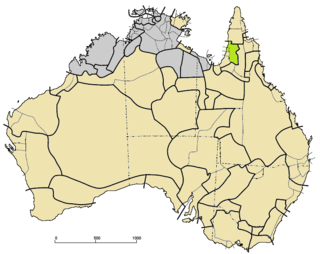
The eastern grey kangaroo is a marsupial found in the eastern third of Australia, with a population of several million. It is also known as the great grey kangaroo and the forester kangaroo. Although a big eastern grey male can typically weigh up to 69 kg (152 lb) and have a length of well over 2 m, the scientific name, Macropus giganteus, is misleading: the red kangaroo of the semi-arid inland is larger, weighing up to 90 kg (200 lb).

The Cape York Peninsula is a peninsula located in Far North Queensland, Australia. It is the largest wilderness in northern Australia. The land is mostly flat and about half of the area is used for grazing cattle. The relatively undisturbed eucalyptus-wooded savannahs, tropical rainforests and other types of habitat are now recognised and preserved for their global environmental significance. Although much of the peninsula remains pristine, with a diverse repertoire of endemic flora and fauna, some of its wildlife may be threatened by industry and overgrazing as well as introduced species and weeds.

Woiwurrung, Taungurung and Boonwurrung are Aboriginal languages of the Kulin nation of Central Victoria. Woiwurrung was spoken by the Woiwurrung and related peoples in the Yarra River basin, Taungurung by the Taungurung people north of the Great Dividing Range in the Goulburn River Valley around Mansfield, Benalla and Heathcote, and Boonwurrung by the six clans which comprised the Boonwurrung people along the coast from the Werribee River, across the Mornington Peninsula, Western Port Bay to Wilsons Promontory. They are often portrayed as distinct languages, but they were mutually intelligible. Ngurai-illamwurrung (Ngurraiillam) may have been a clan name, a dialect, or a closely related language.

Kowanyama is a town and coastal locality in the Aboriginal Shire of Kowanyama, Queensland, Australia.
Wik-Mungkan, or Wik-Mungknh, is a Paman language spoken on the northern part of Cape York Peninsula of Queensland, Australia, by around 1,000 Wik-Mungkan people, and related peoples including the Wikalkan, Wik-Ngathana, Wikngenchera language groups. Wik Mungkan is healthier than most other languages on the peninsula, and is developing and absorbing other Aboriginal languages very quickly.
Wik-Ngathan, or Wik-Iinjtjenj (Wik-Iinychanya), is a Paman language spoken on the Cape York Peninsula of Queensland, Australia, by the Wik-Ngathan people. It is closely related to the other Wik-Ngathan language, Wik-Ngatharr and more distantly to the other Wik languages. In 1981 there were 130 speakers.

The Paman languages are an Australian language family spoken on Cape York Peninsula, Queensland. First noted by Kenneth Hale, Paman is noteworthy for the profound phonological changes which have affected some of its descendants.
Kunjen, or Uw, is a Paman language spoken on the Cape York Peninsula of Queensland, Australia, by the Uw Oykangand, Olkola, and related Aboriginal Australian peoples. It is closely related to Kuuk Thaayorre, and perhaps Kuuk Yak.

The Aboriginal Shire of Kowanyama is a special local government area which is located on western Cape York Peninsula in Queensland, Australia. It is managed under a Deed of Grant in Trust under the Local Government Act 2004.
Kuuk Thaayorre (Thayore) is a Paman language spoken in the settlement Pormpuraaw on the western part of the Cape York Peninsula, Queensland in Australia by the Thaayorre people. As of 2006, 250 of the 350 ethnic Thaayorre spoke the language. It is in a robust position compared to many indigenous Australian languages, as it is still being acquired by children and used in daily interaction.

The Southwestern Paman languages are a family of the Paman languages spoken on the western part of the Cape York Peninsula of Queensland, Australia.
The Thaayorre, or Kuuk Thaayore, are an Australian people living on the southwestern part of the Cape York Peninsula, Queensland in Australia, primarily in the settlement Pormpuraaw, having its foundation in the Edward River Mission.
The Uw Oykangand, otherwise known as the Kwantari, are an Aboriginal Australian people living on the southwestern part of the Cape York Peninsula, in the state of Queensland in Australia. Their neighbours to the northwest are the Yir-Yoront people. Their traditional lands are around the Alice River and the Crosbie River, and further west around the Mitchell River and into Gulf Country.

Nauclea orientalis is a species of tree in the family Rubiaceae, native to Southeast Asia, New Guinea, and Australia. It has many common names, including bur tree, canary wood, Leichhardt pine and yellow cheesewood. It grows to a maximum of around 30 m (98 ft) in height and has large glossy leaves. It bears spherical clusters of fragrant flowers that develop into golf-ball-sized edible but bitter fruits. The yellowish-to-orange soft wood is also used for timber and in woodcarving and folk medicine.
Jandai is an Australian Aboriginal language of the Quandamooka people who live around the Moreton Bay region of Queensland. Other names and spellings are Coobenpil; Djandai; Djendewal; Dsandai; Goenpul; Janday; Jendairwal; Jundai; Koenpel; Noogoon; Tchandi. Traditionally spoken by members of the Goenpul people, it has close affinities with Nunukul language and Gowar language. Today now only few members still speak it.
Alwal National Park is a national park in the Shire of Cook on the Cape York Peninsula in Far North Queensland, Australia.

The Coleman River is a river on the Cape York Peninsula in Far North Queensland, Australia.
The Kaantyu people are an Aboriginal Australian people of the Cape York Peninsula in north Queensland. They live in the area around the present-day town of Coen. Most of their traditional tribal land has been taken over for cattle stations. Kaantju refers to the hook of the yuli, their word for woomera.
The Kokangol (Koko-Gol), or Yuwula, are said to have been an Indigenous Australian people of Queensland. Some dispute this, suggesting the name may be a synonym for Aghu Tharnggala, or may simply be the name of a language consultant.
The Ajabakan were an indigenous Australian people of the Cape York Peninsula of Queensland.








